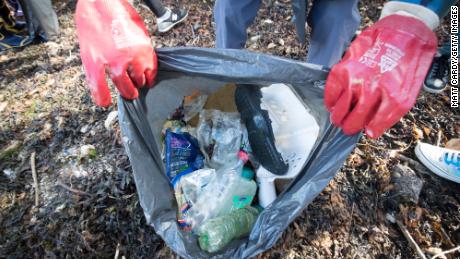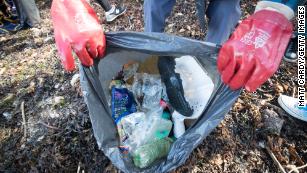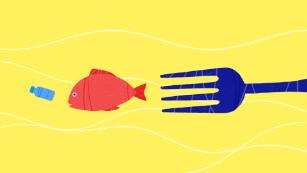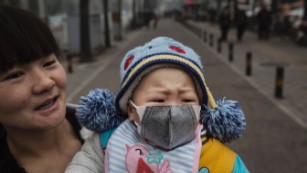Poluição plástica não é apenas no oceano
PLYMOUTH, INGLATERRA - 08 de agosto: Voluntários recolher lixo plástico e resíduos lavados na praia, além de Marine Station da Universidade de Plymouth como eles participam de um evento de sensibilização organizado pela tripulação all-female eXXpedition que estão se preparando para navegar em torno da Grã-Bretanha para destacar o plástico nos oceanos em 8 de agosto de 2017 em Plymouth, Inglaterra. Em uma expedição de navegação pioneira, iniciando e terminando na Estação Marinha da Universidade de Plymouth, um grupo diversificado de mulheres coletará amostras de água para medir micro-plásticos e outros produtos químicos tóxicos, bem como realizar eventos nos vários portos para os quais navegam. incluindo Cardiff, Belfast, Arran, Stornaway, Edimburgo, Londres e Plymouth. (Foto de Matt Cardy / Getty Images)
DIA DA TERRA DE 2018
Os cientistas acreditam que os plásticos representam um risco potencial para a saúde dos seres humanos, mesmo no ar que respiramos
OPINIÃO Líderes: Você fracassou seus filhos na mudança climática
Cientistas esperam que nova enzima "coma" poluição de plástico
Que 24 horas de dano ambiental se parece
Você está comendo plástico?
Plastic pollution is not just in the ocean
Scientists believe that plastics pose a potential health risk to humans, even in the air we breathe
OPINION Leaders: You've failed your kids on climate change
Scientists hope new enzyme will 'eat' plastic pollution
What 24 hours of environmental damage looks like
Are you eating plastic?
It's not just the oceans: Microplastic pollution is all around us
But while marine plastic pollution has been studied for decades, the extent and effects of plastic pollution elsewhere is only just beginning to be explored.
In the past few years, scientists have found microplastics in our soil, tap water, bottled water, beer and even in the air we breathe. And there's growing concern about the potential health risks they pose to humans.
Because research on microplastics on land and in freshwater is still in its infancy, there are no accurate figures on the extent of the problem, but some studies have suggested there are more microplastics on land than there are in our oceans.
Globally, more than 330 million metric tons of plastics is produced each year, leaving potential sources of microplastic pollution all around us.
Where it's coming from
Fertilizers are thought to be one of the leading contributors.
Sewage sludge -- the semi-solid by-product of sewage water treatment -- is used in many countries to fertilize agricultural fields. But the sludge can contain microplastics in the form of microbeads found in cosmetics that have been washed down the sink and clothing fibers that get flushed into sewage systems after synthetic clothes are machine washed.
Exactly what happens to these plastics once they're in the environment is largely unknown. "It's crucially important that we get a hold on what's happening on the land," said professor Anne Marie Mahon of the Galway-Mayo Institute of Technology in Dublin. She studies microplastic pollution and has found it in Irish tap water and well water. Other research recently found microplastics in bottled water around the world.
"It's vital we know if they travel over land," she said. "Do they stay in the top of the soil? Do they become integrated vertically into the soil column, in which case there could be a risk to groundwater?
"Even if they stay on the surface, they could be washed into streams when it rains. And even if they don't get washed into streams, there's still the potential for environmental impact, and then there's the whole terrestrial food chain."
Though there's little known about the effect on plants or on the wider food chain, studies have shown that earthworms exposed to microplastics in soil have increased gut inflammation, slower growth and higher mortality.
As well contaminating the land, microplastics have been detected in the air.
Professor Frank Kelly, director of the Environmental Research Group at King's College London, is researching the presence of microplastics in London's air.
"They're definitely present," he said. "The issue is at what concentration they're present in the air."
One source of airborne microplastics is the same fertilizers that contaminate the ground; as these fertilizers dry out, some of the plastics may get carried away by wind action.
And you can't avoid the plastics by staying at home: They've also been detected in indoor air.
"Inside modern homes there's lots of potential sources of plastic," Kelly said. "Potentially from erosion of synthetic carpets but also fibers could be released by putting on and taking off our clothes."
The big question is, what effect do these plastics have on humans? The short answer is, we just don't know, but scientists, including Kelly and Mahon, believe there is a potential health risk.
The health risks
One risk stems from the fact that microplastics passing through wastewater plants can pick up harmful bacteria, which they can carry with them. If we ingest the plastics, we may ingest the bacteria.
Another is that plastics have a number of chemicals added at the manufacturing stage, and it's possible that these are released in the body.
"In sufficient concentrations the chemicals can injure and kill cells," Kelly said. "The cells may be replaced successfully, or they may not. [There could be] damage to protein and DNA and things like that. But at the moment, we don't know if this is happening."
And while microplastics are too big to be absorbed by our cells, if they become broken down into fragments in the nanometer size range, it's possible they could be absorbed in our circulatory system or pass into our organs, Mahon said.
But whether that's actually happening is another unknown.
It's one reason why scientists and environmental groups are saying there's an urgent need for more research.
And with global plastic production expected to triple by 2050, along with the fact that some plastics can take hundreds of years to biodegrade, microplastic pollution is a problem that isn't going away.
copy https://edition.cnn.com/
















Nenhum comentário:
Postar um comentário